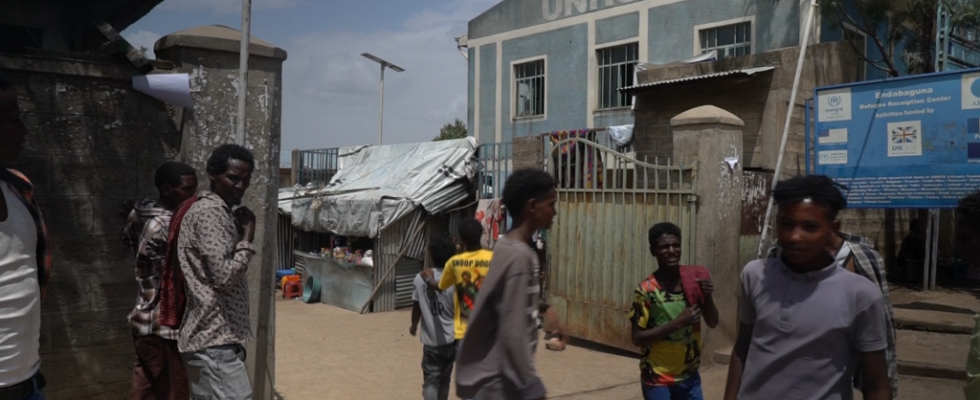The war in Tigray between federal forces, supported in particular by neighboring Eritrea, and Tigrayan rebels, left around 600,000 dead between 2020 and 2022, and forced several million people to leave their homes in this northern region of Ethiopia. A year and a half after the signing of a peace treaty, 1.5 million refugees are still in camps waiting to return home, like those who continue to flock to Endabaguna camp. , south of the town of Shire, in western Tigray. Reporting.
3 mins
With our special correspondent in Shire, Clothilde Hazard
In Ethiopia, the Pretoria Accords provide for the return of people displaced by the war. However, some 1.5 million refugees are still in camps waiting to return home. They come from the west and south of Tigray, territories still occupied by Amhara and Eritrean forces.
Forced displacement continues: nearly 60,000 Tigrayans have still had to leave their homes in recent months. In the meantime, the displaced live in misery in camps where they lack everything, such as in Endabaguna, south of the town of Shire, in western Tigray.
“ Going home is all they ask for »
Hayelom has just arrived at the Endabaguna site. Alone, he doesn’t know anyone. He had to flee his lands in the west, occupied by military forces from the neighboring Amhara region.
“ They came to my land at nighthe says. They stole livestock and what they found on the farm. One day they shot me in the right arm and it broke. It hurted so bad. I couldn’t take care of myself properly. Afterwards, I fled here “.
This evening, he will sleep on a mat on the ground, in a shed, with fifteen other people. Every day, nine families and six single people arrive on the site, on average. Without assistance, they crowd into the only unsanitary shelters available.
Read alsoWar in Tigray: a peace process that is moving slowly despite negotiations
Representing displaced people, Mulugeta Niguse registers the new arrivals. “ Before the war, this building was used to register Eritrean refugeeshe explains. It is not designed to accommodate that many people. This is way beyond the capabilities of this place. Many new arrivals are on the streets and begging “.
Haftom is on-site coordinator for the NGO Innovative humanitarian solution. “ If they can return home, they can harvest, work, resume an activity. This is all they are asking from the government and the international community “, he assures us.
In May, 5,000 people were relocated to another camp a few kilometers away where they receive better humanitarian support. Forty-eight thousand displaced people, however, are still in Endabaguna.
Transitional justice in Ethiopia: “A simple national mechanism, politically manipulated at all levels, cannot serve the case of Tigray”
The victims of the war in Tigray are also awaiting reparation through transitional justice. The census of victims and crimes is a long-term task that the Commission of Inquiry into the Genocide in Tigray is trying to do meticulously. This organization, founded in May 2022, by the interim government of Tigray, is conducting an in-depth investigation on the ground. It comprehensively assesses the extent of human and material losses by documenting all the human rights violations that have been committed against the population of Tigray. Transitional justice is led by the Ethiopian federal government. But for Yemane Zeray, director of the commission of inquiry, this is not enough.
“ When we see the way in which this has been carried out so far, we do not believe that justice can be obtained at the national levelhe says at the microphone of Clothilde Hazard. Unless new mechanisms are negotiated. The international community must intervene and understand the nature of the problem. Because we believe, as many analysts and researchers have revealed, that this was the most devastating war of the 21st century, in which many international actors intervened, with a complete siege and massive displacement of populations , where many people suffered directly from the war but also indirectly with famine “.
Yemane Zeray continues: “ So, in this situation, a simple national mechanism, politically manipulated at all levels, cannot serve the case of Tigray. There are things we cannot do at the national level. How will we judge the Eritreans involved? How will we judge the atrocities that have been committed on civilians with government drones? There are also all the displaced people. All of this must be carried out at the right level, in a legal manner. »
As a reminder, for the United Nations, transitional justice encompasses “ the full range of various processes and mechanisms implemented by a society to attempt to address mass abuses committed in the past, with a view to establishing accountability, dispensing justice and enabling reconciliation “.
